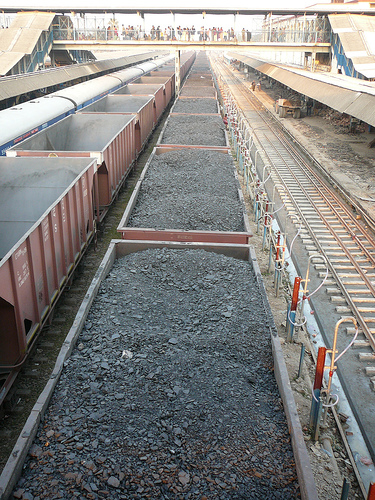Where you find coal, you’re likely to find coal dust. I’ve already cataloged dust problems in Alaska, northern British Columbia, southern British Columbia, Virginia, and Australia. Here’s a look at India.
Before we proceed though, let’s get clear on something: India’s handling of coal is atrocious. It’s far beneath the standards that North American coal handlers employ (and that is not to be intrepreted as praise for North American coal firms). India’s problems do not, therefore, represent a direct comparison to possible Northwest terminals. Nevertheless, India’s experience is important to consider because it is a major market for importing coal.
Although the country has sizeable domestic coal reserves, it is also one of the world’s largest importers—and a much-talked-about destination for shipments from the Northwest. It is concerning then, that India’s ports handle coal so poorly that they do serious damage to nearby communities. In a very real sense then, it is possible that Northwest coal exports would result in even more coal-related damage to India’s public health.
Let’s start with Chennai, on India’s east coast, where coal dust from the port is a constant presence—and one with serious medical consequences:
Gunavathi… A resident of Royapuram and a patient suffering from chronic respiratory problems, she finds coal dust everywhere — in the milk that she boils, on the clothes that she hangs for drying, and on the floors of her house. Residents of Royapuram will soon have to wear masks round-the-clock to protect against coal particles in the air, says MS Ravi, a senior cardiology professor at Government General Hospital, Chennai, who lives in the area.
Medical experts and doctors practising in Royapuram say that they are seeing more cases of respiratory diseases in the area due to exposure to particulate pollution from the coal handling yard at Chennai Port.
By March of 2011, the Chennai port was claiming it was taking all available measures to control the spread of dust. Yet in June the Madras high court found:
One cannot walk barefoot or touch the walls of this high court, in spite of regular cleaning of the premises, as the iron ore/coal dust particles settling in the premises in high quantities every day would make hands and foot dirty in thick black colour.
That’s in reference to the court’s own building, which is routinely contaminated by coal dust. According to the Times of India:
The air in residential areas like Mylapore, Anna Nagar and T Nagar is hardly breathable, with respirable suspended particulate matter (RSPM) going beyond the danger mark of 60 microgram per cubic metre. T Nagar has 121 microgram and Kilpauk 91 microgram of RSPM per cubic metre.
The area’s university, located about 2 miles from the coal port, is hardly better off. Again, the Times of India:
The communication and journalism students of the University of Madras sit caged in their classroom. The windows are bolted tightly and the ventilation is blocked… The black particles are everywhere: The classroom walls, floor, labs, computer screens and deep in the lungs of students and staff of the varsity. The walls of the class and the department rooms are a shade of black, the polished red mosaic floor are smudged dark, computer screens have dark specks sticking on them howmuchever you wipe it.
In Visakhapatnam, on India’s northeast coast, coal dust from port operations, which have long plagued the old town neighborhood, recently spread across much of the rest of the city. According the The Hindu newspaper:
“Layers of dense coal dust were seen at many of the houses in our area during the last 20 days. The presence of fine particles of coal dust in the air is causing breathing and lung problems,” says N. Venkateshwarao, a retired Principal of Mrs. A.V.N. College, who stays at Seethammadhara North Extension.
Interestingly, the AP Pollution Control Board (AP PCB) at Balayya Sastry Layout hasn’t been spared of the problem either. A thin layer of black dust has spread all over the premises. Pass your finger across the tables and you are sure to find a black layer on it.
The port at Visakhapatnam is now promising to undertake modernization measures, but it remains to be seen whether conditions will improve.
In Vasco, on India’s west coast near Goa, residents complain about coal dust escaping from overloaded or poorly-covered trucks bearing coal to the town’s port. It’s also worth mentioning that, severe as they are, India’s coal dust woes are hardly confined to ports. Mining, trucking, and poor handling at power plants have left many regions severely contaminated, polluting residential neighborhoods, destroying crops (apparently even leading to mass suicide in at least one case), displacing whole villages, and creating a serious public health threat. It’s a tragedy in the making.
Thanks to Kathy Washienko for research assistance.








